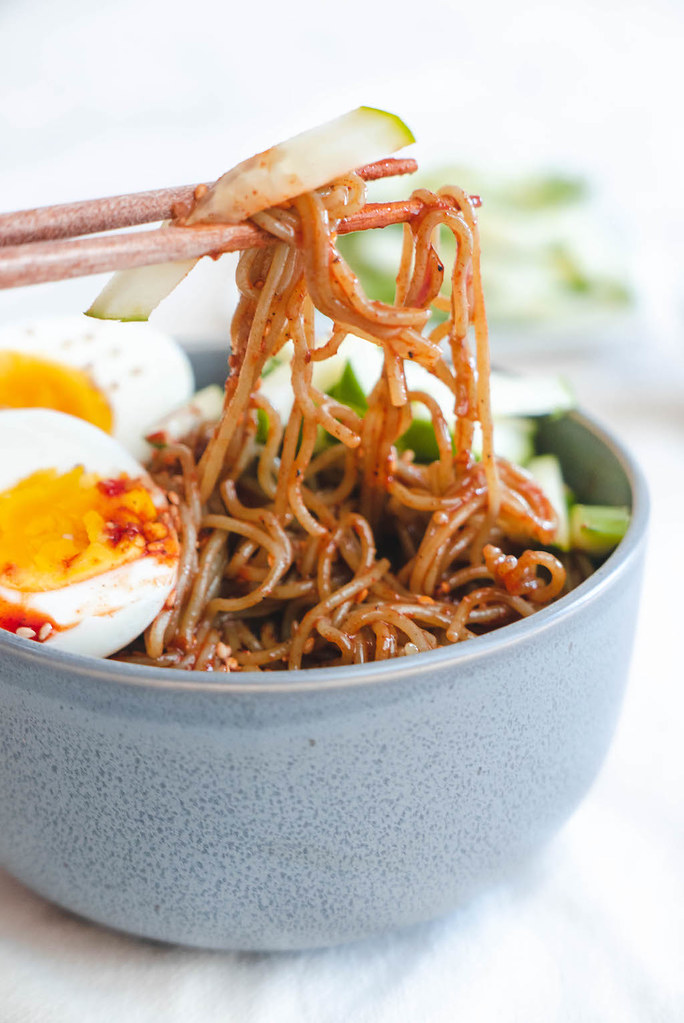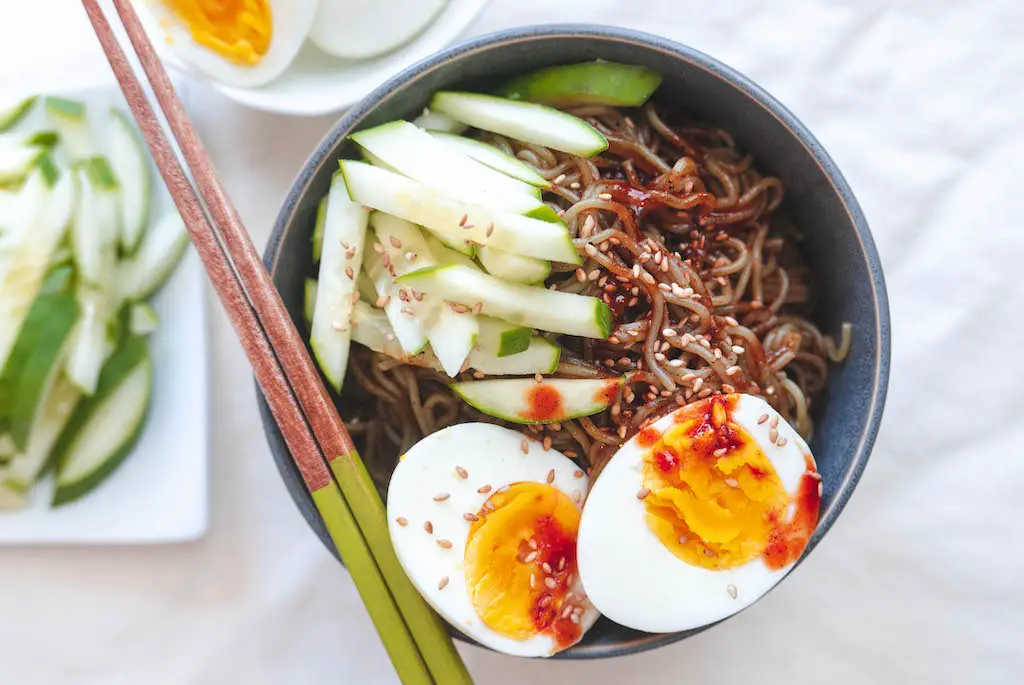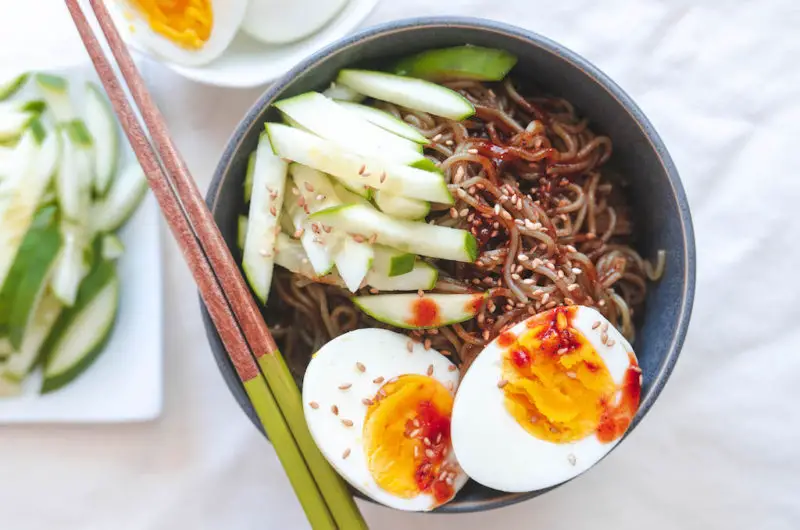This post may contain affiliate links. Please read my disclosure for details at the bottom of this page. As an Amazon Associate, I earn from qualifying purchases on this spicy Korean cold noodles recipe. We hope you enjoy learning how to make bibimmyeon!
In South Korea, certain foods are known to help beat the heat during the hot late spring and summer months. If you asked a random person on the street what to eat, they would most likely reply with one of two options:
- Cold Noodles Dishes: Though uncommon in many countries, icy cold noodles are a must-have treat to beat the heat in both North and South Korea. You can find many different styles of Korean cold noodles using diverse types of sauces, noodles, and fresh ingredients.
- Spicy Dishes: In Korea, people say that the more you sweat, the cooler you feel. As such, people often eat extremely spicy dishes to sweat more and beat the heat during the summer. Dakbal (spicy chicken feet) and bibim naengmyeon (a style of spicy cold noodle served in crushed ice) are well-known examples of summer spicy dishes.
Like bibim naengmyeon mentioned above, this week’s recipe is actually a noodle dish that fits into both the cold and spicy categories. For this post, we are introducing bibimmyeon! Slightly sweet, savory, and spicy, these cold noodles will leave you feeling refreshed on a hot summer evening! (Gluten-free, soy-free, vegan, vegetarian options included in the frequently asked questions part of the post!)
Bibimmyeon (Spicy Korean Cold Noodles)
Before jumping into the recipe, let’s learn all about these quick and easy spicy Korean cold noodles!

What Does ‘Bibimmyeon’ Mean?
Have you ever heard of bibimbap? If so, you know that bibimbap is a Korean rice bowl filled with vegetables and spicy sauce. In Korean, ‘bibim’ means ‘mix’ and ‘bap’ means ‘rice.’ Thus, when translated into English, bibimbap means ‘mixed rice.’
Like above, ‘bibim’ means ‘mix.’ Then, ‘myeon’ refers to ‘noodles’ in Korean. So, when translated, bibimmyeon means ‘mixed noodles.’
What is Bibimmyeon (비빔면)?
Like we stated above, bibimmyeon (비빔면) refers to a style of spicy Korean cold noodles. This noodle recipe is actually a simple, quick, and easy homemade version of the Korean instant ramen of the same name. You may have seen the packets of this instant ramen in your local grocery store or online. Below, we added a photo of the ramen packaging for your reference.

Though you can easily find the instant version, we wanted to share a homemade version you can easily make at home in your kitchen!
Korean Cold Noodles Tips and Tricks
When making these Korean cold noodles, here are some tips to make cooking even easier!
- Buying Noodles: We recommend buying ramen noodles without the seasoning packets. Typically, you can find ramen in the Asian section of the grocery store. For those who need gluten-free noodles, you can now find versions in the Asian section as well!
- Cooking the Noodles: Cook the noodles per the instructions on the packet you chose. Then, dump them directly into a colander and run cold water over the noodles. Not only does the cold water keep the noodles from clumping and becoming mushy, but it also preps the noodles for this cold dish!
- Making the Sauce: When making the sauce, combine everything in a separate bowl instead of directly with your noodles. This way, you can gauge the spice level you desire.
- Adding the Sauce: When adding the sauce, instead of dumping it all in, try adding a little bit at a time until you find the spice levels you want. Then, if you have any leftover sauce, store it in the refrigerator for up to a week. You can make noodles again later if you have leftovers!

Bibimmyeon Frequently Asked Questions
Below, we listed some questions you may have about this dish. If we did not answer your question, feel free to write it in the comment section or email us at [email protected].
Why Should I Make This Dish From Scratch?
Why make this dish from scratch if you can easily buy the instant version in grocery stores and online?
Firstly, I find making this Korean noodle dish from scratch way more enjoyable than making the instant version. Honestly, it takes approximately the same amount of time. But, when making it from scratch, you can change the spice levels and other flavor components. In the end, it makes the noodle dish way more fun to make and it tastes better too!
Secondly, instant ramen often has very unhealthy and cheap ingredients that allow the ramen to stay on shelves for an extended period. Making this recipe from scratch means you are eliminating a lot of added chemicals and sodium from the dish!
Finally, many people want to enjoy this dish but are unable to because of food restrictions and allergies. When making this dish from scratch, you can alter the recipe slightly to make it fit into your dietary needs! This leads me to the next question~

Can You Make This Dish Gluten-Free? What About Soy-Free?
Can you make this dish gluten-free? Yes, you can easily make this dish gluten-free! While it used to be difficult, you can now easily find gluten-free ramen, gochujang, and soy sauce at the grocery store or online. Admittedly, it can cost a little more to make this dish gluten-free. But, for all the people out there with wheat allergies and celiac disease, it is totally worth it! You can finally make a dish you saw people eating in dramas!
- We use the Lotus Foods brand for the gluten-free ramen noodles in our house. As someone with celiac disease, I was so excited to find their gluten-free ramen noodles! My husband, who grew up eating normal ramen in Seoul agrees that they taste excellent!
- If you need help finding gluten-free gochujang, check out our post about the best gluten-free gochujang brands!
What about soy-free? Once again, yes! You can easily make this dish soy-free as well! To do so, use coconut aminos instead of soy sauce. On our list of gluten-free gochujang brands, we also list one gochujang that is soy-free. If you do not use the gluten- and soy-free version we recommend, make sure to check the ingredients for soy in the brand you buy!

Can You Make This Dish Vegetarian or Vegan?
Everything in this dish is naturally vegetarian and vegan! But, for the vegans out there, people in Korea often add a boiled egg on top of this spicy cold noodle dish. You can omit the egg and add some cold cubed tofu instead!
What Do I Serve With the Noodles?
Typically, people top bibimmyeon with sesame seeds, sliced cucumber, and a boiled egg. On the side, they often eat kimchi!
My husband and I LOVE eating bibimmyeon with grilled samgyeopsal (pork belly) barbecue as well.
How Do I Store Leftovers?
Like we stated above, we recommend adding sauce bit by bit until you get the spice level you want on your noodles. You can store the extra sauce for up to a week in an airtight container in the refrigerator.
If you cannot finish your noodles, we recommend eating the cooked spicy noodles within 24 hours. The longer the noodles sit, the harder they will get. Because they are cold noodles, you cannot reheat them to soften the noodles back up.

Do You Like Spicy Korean Cold Noodles??
In the end, did you enjoy eating our bibimmyeon recipe? If so, let us know in the comment section! Also, if you have any questions, you can leave them in the comment section!
If you would like to try more Korean food, check out the recipes below!
Korean Food and Drink Recipes:
- Andong Jjimdak (Korean Braised Chicken)
- Mayak Eggs (Korean Marinated Eggs)
- Maneul Jangajji (Korean Pickled Garlic)
- Romaine Sangchu Geotjeori (Korean Romaine Lettuce Salad)
- Soju and Tonic (A Korean Soju Cocktail)
- Soju Caipirinha (A Korean Take on Brazil’s National Drink); and
- Cheese Kimbap
If you have any questions or comments, you can also email us at [email protected].
Finally, we would love to hear from you through our social media as well! You can follow us at @carvingajourney on Instagram, Twitter, Facebook, and Pinterest. Or, if you would like more articles like these, you can subscribe to our blog by joining our mailing list. We hope you enjoyed our spicy Korean noodles (aka bibimmyeon) recipe! Thank you so much for stopping by!
Carving A Journey is a participant in the Amazon Services LLC Associates Program, an affiliate advertising program designed to provide a means for sites to earn advertising fees by advertising and linking to Amazon.com. Although we may earn commissions for our endorsement, recommendation, testimonial, and/or link to any products or services from this website, these opinions are my own and I fully support these products.


